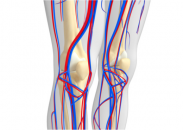Three randomized studies showed exercising significantly improves 6-minute walk outcomes in patients with peripheral artery disease (PAD). However, many participants randomized to exercise did not perceive changes, and sometimes even got worse. These findings suggest a significant discrepancy between objective and perceived change in walking ability among PAD patients. 400 patients with peripheral artery disease…
ELUVIA: DES in Complex Femoropopliteal Lesions
Paclitaxel-eluting stent Eluvia showed promising results after two years with a revascularization freedom rate of 80% despite the fact that these were complex femoropopliteal lesions. As the safety of paclitaxel-eluting devices becomes more consistent, more studies on its efficacy are being published. Back in 2018, the safety of paclitaxel-eluting balloons and stents was under scrutiny…
ACC 2021 | SAFE-PAD: Paclitaxel-Eluting Devices in Peripheral Disease
This work was conducted alongside the US Food and Drug Administration (FDA) to investigate the association between all-cause mortality and paclitaxel-eluting devices in peripheral vascular disease. According to data from SAFE-PAD, presented at the American College of Cardiology (ACC) 2021 Congress and simultaneously published in JAMA, there is no increase in mortality compared with conventional…
Optimal Medical Treatment Under-used in Vascular Peripheral Disease
Less than half of patients undergoing endovascular revascularization for peripheral artery disease to their lower limbs are discharged with optimal medical treatment. Their traditional risk factors are predictors of a more comprehensive treatment; however, women, patients with higher risk of thrombosis, and those more likely to lose a lower limb, are far from being treated…
Diabetes and Peripheral Vascular Disease: Old Drugs, New Evidence
This paper, recently published in JAHA, showed that patients with type 2 diabetes mellitus exhibiting lower-limb vascular disease benefit from combining cilostazol and clopidogrel. Treatment for at least 6 months with clopidogrel (75 mg/QD) plus cilostazol (100 mg/BID) significantly reduces ischemic events—including stroke, infarction, and death from vascular causes—compared with clopidogrel monotherapy. Adding cilostazol reduces ischemic events, but that…
Drug-Coated Balloons in Critical Ischemia: The Paradigm of Randomized Evidence vs. Logbooks
This research, which included thousands of patients treated for chronic inferior limb ischemia with drug-coated balloons, did not show an association between said devices and the increased mortality observed in some randomized trials. The long-term evidence from plenty of real-world patients contradicts what has been shown in randomized trials, leaving an information gap. Endovascular revascularization…
The Key We Are Overlooking in Peripheral Vascular Disease
To change the prognosis of peripheral vascular disease patients, a referral for supervised exercise is paramount. This should be a cultural change, not only an individual recommendation. A physically active lifestyle reduces the risk of cardiovascular events and functional impairment in patients with peripheral vascular disease. The novelty of this work (forthcoming in Eur J…
Consensus on How to Conduct Follow-Up in Peripheral Vascular Disease
Peripheral vascular disease involves multiple areas and, therefore, can have very different presentations (from complete lack of symptoms to disabling symptoms). Depending on clinical presentation, general condition, anatomical localization, and lesion extension, revascularization can be indicated alongside optimal medical treatment. In 2017, guidelines with indications for revascularization were published; however, maintaining long-term patency can be…
Angioplasty vs. Surgery in Lower Limb Ischemia
This analysis of data from an already published study, “Bypass Versus Angioplasty in Severe Ischemia of the Limb (BASIL-1),” confirms the superiority of bypass over balloon angioplasty, with or without stenting, in patients with chronic lower limb ischemia who require a femoropopliteal intervention. While analyzed interventions took place between 1999 and 2003 (a fact subject…
New FDA Updates on Paclitaxel Device Outcomes
A new FDA letter confirms late mortality signal with paclitaxel eluting stents and paclitaxel coated balloons in peripheral territory. Even though this recently published letter confirms data, there are no new recommendations on the use of these devices. After careful consideration of their own analyzis outcomes and a 2-day discussion of an advisory panel especially…
- 1
- 2









